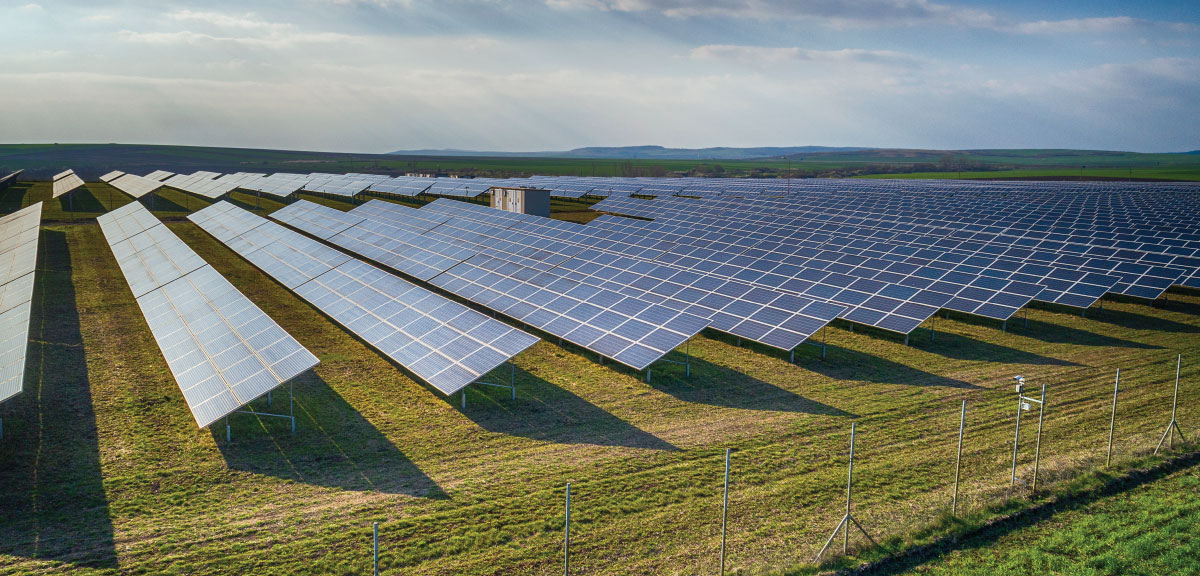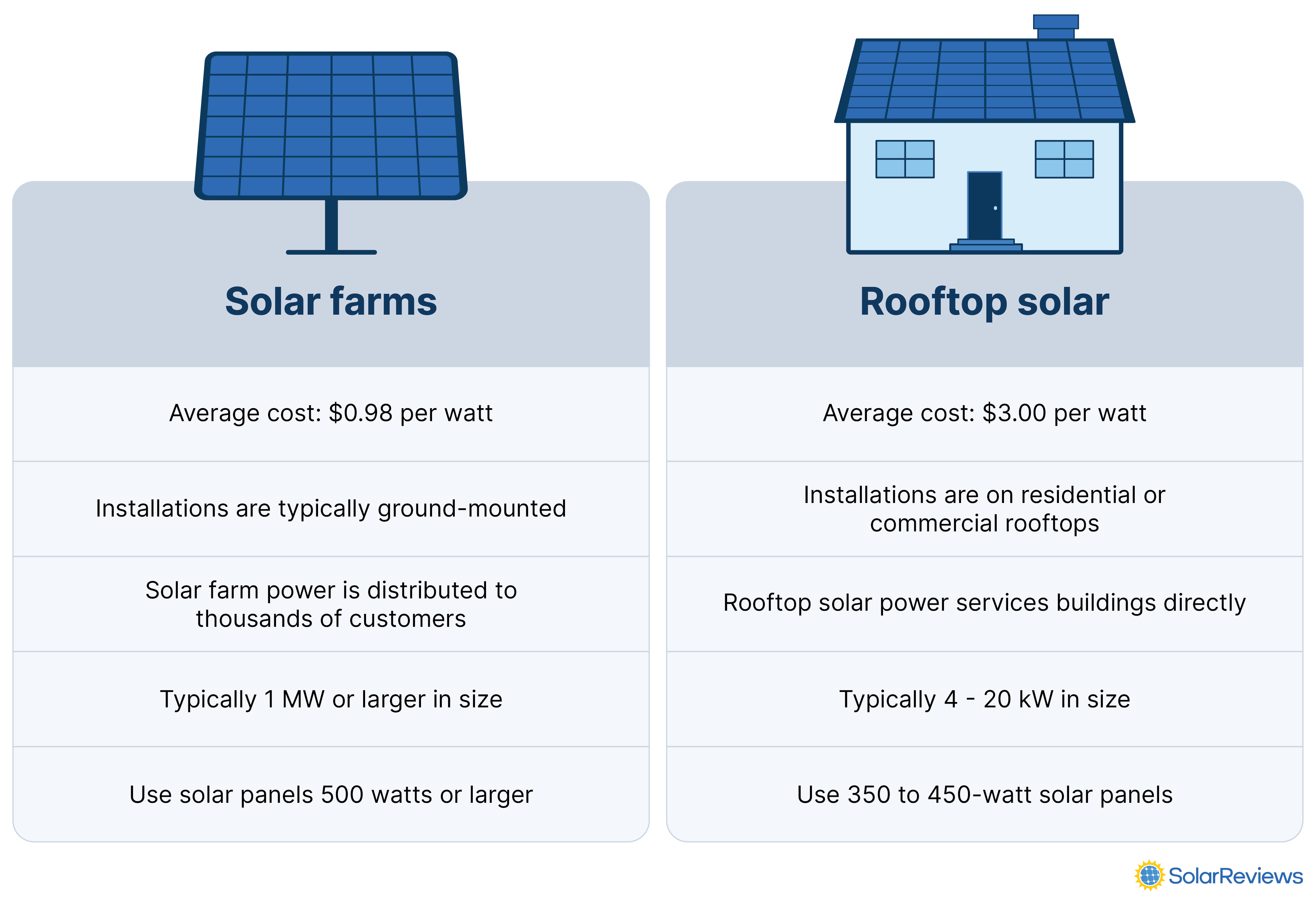Updated 11 months ago
What is a Solar Farm? Costs, Pros, and Cons Explained
Written by
Jamie Smith

Find out what solar panels cost in your area
Key takeaways
-
Solar farms are large ground-mounted solar installations that occupy vast areas of open land.
-
Solar farms are mainly used for utility-scale or community solar applications, both of which provide green energy for large numbers of people.
-
Solar farms are typically 1 MW in size or larger, with the largest solar farm totaling over 3,500 MW of generating capacity.
-
At $0.98 per watt, a 1 MW solar farm will cost roughly $980,000, not including land acquisition costs.
Solar farms are large ground-mounted solar installations that occupy vast areas of open land and provide clean energy generated by the sun.
By large, we mean solar installations with megawatts of capacity. To put that into perspective, a one-megawatt solar farm is the equivalent of about 166 home solar systems!
Let's take a look at how solar farms work, how much they cost, and their pros and cons.
What is a solar farm?
Solar farms are large-scale solar installations typically consisting of thousands of ground-mounted solar panels.
Using photovoltaic (PV) panels, solar farms harness the sun's energy and convert it into electricity that is sent to the electrical grid for distribution and consumption. Sometimes, solar farms use different solar technologies, like concentrated solar power systems, to generate electricity.
Solar farms can span for acres and are sometimes called solar power stations or solar parks. You can think of solar farms as a more environmentally friendly version of traditional fossil fuel power plants designed to generate large amounts of energy.
How do solar farms work?
Most solar farms use solar panels to turn sunlight into electricity. The sun's energy hits the surface of a solar panel and knocks electrons loose, creating an electrical current. Then, an inverter converts the electrical current into usable electricity for homes and businesses.
There are two main types of solar farms: utility solar and community solar.
Utility-scale solar farms are similar to other power plants that feed power directly onto the electric grid. Typically built by developers with long-term contracts, these massive solar arrays generate power to be sold at wholesale prices and sent along power lines to be distributed to customers. These installations can range from 1 megawatt (MW) to a whopping 2,000 MW and are some of the largest projects in the solar industry.
Community solar projects operate a bit differently. Typically sized at 5 MW or less, community solar farm projects are intended to provide power to subscribers or members who pay for a share of the system.
The solar energy used from this share is typically lower than the retail electric rate, providing subscribers with electricity bill savings. Community solar caters to renters and homeowners who cannot install solar or low-income residents interested in solar power.
How much does a solar farm cost?
Data collected by the Solar Energy Industries Association (SEIA) shows that utility-scale solar will cost an average of $0.98 per watt in 2025, not including the cost of purchasing land.
Thus, a 1 MW solar farm would cost a whopping $980,000. The largest solar power plant in the world, the Xinjiang Solar Park in China, is over 3,000 MW in capacity, meaning its costs would be in the billions!
Solar farm costs are more than just panels. Factors like location, labor, permitting, design, insurance, and taxes affect the price of installing large-scale solar farm projects.
Why do solar farms have a lower cost per watt than home solar installations? Solar farms take advantage of economies of scale. They are using such large amounts of equipment that it makes the cost per unit lower, and soft costs like labor are distributed across the enormous size. Think of it like buying bulk groceries - when you buy a family pack of chips, each bag costs a little bit less than if you purchased the standard size.
How is a solar farm different from rooftop solar?
Although they both utilize the sun's power to generate electricity, there are critical differences in how solar farms and rooftop solar operate. These differences are listed below:

Because of economies of scale, solar farms have a lower cost per watt than rooftop solar installations. However, because of their enormous size, the overall cost of a solar farm is much higher.
One of the biggest differences between solar farms and rooftop solar installations is how their energy is used. The solar electricity made by solar farms is distributed to hundreds, even thousands, of people. Rooftop solar is designed to supply energy directly to the building it's installed on.
The two are also installed differently: solar farms are typically ground-mounted systems that are 1 MW or larger in size, while rooftop systems are fixed directly to a roof and are usually between 4 and 20 kW in size. Solar farms also use larger solar panels that have an output of at least 500 watts. Home solar installations usually use smaller panels, between 350 and 450 watts.
Solar farm pros and cons
Solar farms come with plenty of benefits economically and environmentally but are also prone to some setbacks. The pros and cons of a solar farm are listed below:
Pros
-
Zero-emissions
-
Low operating costs
-
Cheaper power source
-
Increases solar accessibility
-
Renewable energy source
-
Flexible design and locations
Cons
-
Can impact surrounding area
-
Aesthetics
-
Intermittent energy source
-
High upfront cost
Advantages of solar farms
Zero-emissions: Solar farms are an excellent way to distribute electricity to the power grid without fossil fuels or releasing harmful emissions into the atmosphere like a typical power plant, contributing to the fight against climate change and reducing the carbon footprint.
Low operating costs: Solar farms are pretty self-sustainable and don’t require as much maintenance or supervision as other power plants, leading to lower operating costs.
Cheaper power source: Generating electricity from solar is more cost-effective than other power sources, like fossil fuels or geothermal power.
Increases solar accessibility: There are solar farms dedicated to community solar programs that reach people who can’t usually go solar, like renters or low-income homeowners.
Renewable energy source: Solar power is considered renewable because, unlike fossil fuels, it doesn’t deplete the energy source as it is used.
Flexible design and locations: Rooftop solar is limited by the design of the home or business they’re installed on, while solar farms have a little more flexibility in creating a system that ensures optimal solar production.
Disadvantages of solar farms
Can impact surrounding area: Since solar farms are so large, they can negatively affect the ecosystems in which they’re installed. They could potentially impact the migration route of some animals or amplify the effects of erosion in the soil during installation.
Aesthetics: Solar farms take up vast acres of land, which some may consider an eyesore.
Intermittent energy source: Even if your solar farm is free of shade, the amount of energy solar panels produce is still weather-dependent. Energy production can be inconsistent due to the sun's intensity varying with location, time of year, and time of day.
High upfront cost: Although utility-scale solar has a lower cost per watt than residential solar, the sheer size makes a solar farm such a significant investment, reaching millions of dollars to build. Developers or contractors who don’t prioritize solar as a power source might not be willing to invest in a project of this scale.
Is it worth it to build a solar farm?
Due to its cost and the amount of land needed, building a solar farm is not feasible for the average person. If you’re a homeowner and want to use a solar farm, see if community solar options are offered in your area.
However, it is worth it for large investors and contractors to build solar farms to shift away from fossil fuel power and provide clean energy throughout the country.
Also, solar farms utilized for community solar energy projects are a great way to expand access to solar by making it possible for renters, low-income families who cannot afford an installation, or homeowners who live somewhere unsuitable for rooftop solar to benefit from solar energy.
The best way to know if solar panels work for your roof is to speak with local solar contractors. Solar installers can provide free quotes to help you understand the costs and savings of solar panels in your area.
Solar farms FAQs
Jamie is a Content Writer and researcher at SolarReviews. A recent graduate of La Salle University in Philadelphia, Jamie earned her B.S. in communications with a concentration in journalism, mass media, and public relations. Jamie has previously worked at a marketing company where she had the opportunity to highlight and promote small business owners through long-form stories and interviews. With a deep-rooted passion for creativity, Jamie stri...
Learn more about Jamie Smith